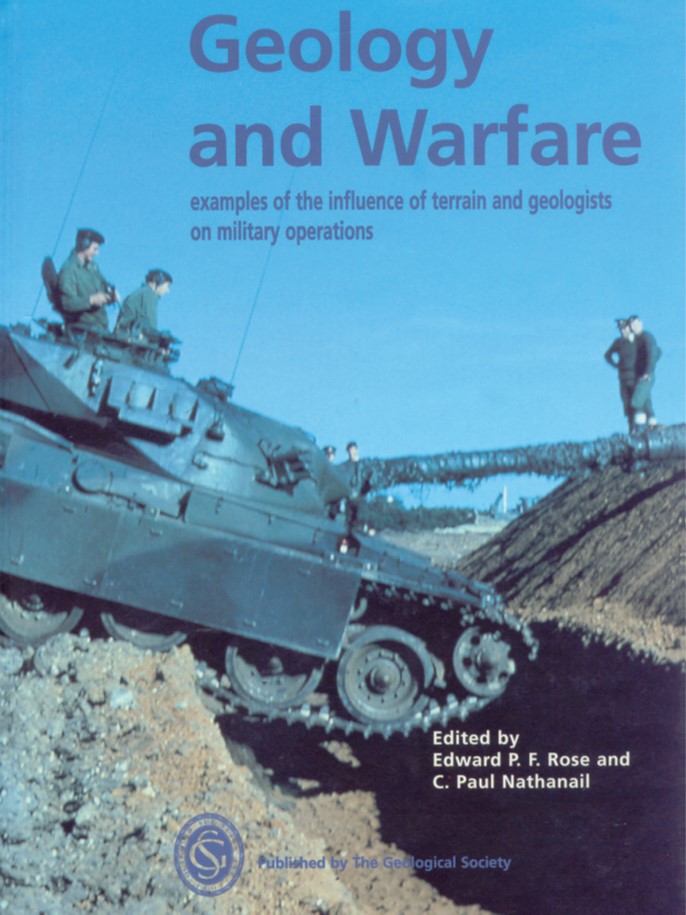Warwick, UK, 1996
(Conference summary reproduced with permission; original text published in: Häusler, H. 2009. Report on National and International Military Geo-Conferences held from 1994 to 2007, MILGEO, Nr. 30E, Austrian Ministry of Defence and Sports).
In 1996 the “Engineering Geology Group” of the London Geological Society organised an “Applied Science Conference” including a one-day symposium on the “Influence of Terrain and Geologists on Military Operations” at Warwick, situated about four miles north of Coventry Airport. The military geologists Edward P. F. Rose, Department of Geology, Royal Holloway University of London, jointly organised this second conference with C. Paul Nathanail, School of Chemical, Environmental and Mining Engineering, University of Nottingham, UK (ROSE & NATHANAIL, 2000). The contributions are listed in Table 2.
Table 1 – Papers
| Author | Title | Subject |
|---|---|---|
| BLAKE | Geological influences on the siting of military airfields in the United Kingdom | Geology, airfields, UK |
| DOYLE | A field guide to the geology of the British sector of the Western Front, 1914-18 |
Geology, WWI |
| DOYLE, MATTHEW & COCKS | Geology and warfare on the British sector of the Western Front 1914-18 |
Geology, WWI |
| HALSALL | Geological constraints on battlefield tactics: examples in Britain from the Middle Ages to the Civil Wars |
Geology, historic |
| HALSALL | Geological constraints on the siting of fortifications: examples from medieval Britain |
Geology, historic |
| HÄUSLER & WILLIG | Development of military geology in the German Wehrmacht 1939-45 |
Geology, WWII |
| HÄUSLER | Deployment and role of military geology teams in the German army 1941-45 |
Geology, WWII |
| MOSELEY | From dowsing to hydrogeology in the Royal Engineers 1939- 70. |
Geology, hydrogeology |
| NATHANAIL | Geoenvironmental security – the challenge for tomorrow’s geologists? |
Geoenvironmental security |
| PAREYN & ROSE | A field guide to British military applications of geology in Normandy during 1944 |
Geology, WWII |
| PITTMAN | Geologists and the American Civil War | Geology, historic |
| ROSE | Geology and the fortress of Gibraltar | Geology, Gibraltar |
| ROSE | The military service of G. B. Greenough, founder president of the Geological Society |
Geology, historic |
| ROSE, HÄUSLER & WILLIG | Comparison of British and German applications of geology in world war |
Geology, WWI, WWII |
| ROSENBAUM & ROSE | Operational roles for military geologists | Geology, operations |
The conference book of ROSE & NATHANAIL (2000) comprises the following seven parts (1-7) with authors in parenthesis:
- Geology and military history (HALSALL)
- Early geologists and the armed forces (ROSE; PITTMAN)
- Battlefi eld geology in world war (ROSE, HÄUSLER & WILLIG; HÄUSLER & WILLIG; HÄUSLER)
- Military use of terrain (DOYLE, BENNETT & COCKS; ROSE; BLAKE)
- Recent military geologist roles (MOSELEY; ROSENBAUM & ROSE)
- Future military geologist roles (NATHANAIL)
- Field guides to world war battlefields in northern France (DOYLE; PAREYN & ROSE)
In the following the military geoscientists and their subjects of papers are briefly presented according to the above listed chapters of the conference proceedings:
- Trevor J. Halsall, who was employed at the Postgraduate Research Institute for Sedimentology, University of Reading (Reading, UK) contributed two lectures on geological constraints on the siting of fortifications, first with examples from medieval Britain, and second with examples from the Middle Ages to the Civil Wars.
- Edward P. F. Rose from the Department of Geology, Royal Holloway University of London, contributed to the military service of G. B. Greenough, the founder president of the London Geological Society.
- Walter Earl Pittman from the Department of History and Social Sciences, University of West Alabama (Alabama, USA) reported on geologists and the American Civil War of 1861-1865.
- A series of lectures on battlefield geology in the two world wars were given by Edward P. F. Rose from Royal Holloway (London, UK), Hermann Häusler at that time Institute for Geology, Vienna University (Austria) and Dierk Willig, professional military geologist of the German Armed Forces, at that time II Korps, Abteilung Geophysik at Ulm (Germany). All three authors contributed to a comparison of British and German applications of geology in WWI and WWII. Hermann Häusler and
- Dierk Willig gave a lecture on the development of military geology in the German Wehrmacht 1939-1945 and Hermann Häusler explained in detail the deployment and role of military geology teams in the German armies 1941-1945.
- Peter Doyle, Matthew R. Bennett and Fiona M. Cocks, all three from the School of Earth and Environmental Sciences, University of Greenwich (UK) gave a report on geology and warfare on the British sector of the Western Front 1914-18.
- Based on his long-lasting experiences as military geologist at Gibraltar, Edward P. F. Rose (Royal Holloway London University) gave a lecture on the geology of the Gibraltar fortress.
- Ronald N. E. Blake from the Department of Building and Environmental Health, The Nottingham Trent University (UK) described geological influences on the siting of military airfields in the United Kingdom.
- Frank Moseley, geologist at the University of Birmingham (UK) gave an overview on the role of military geologists, and particular hydrogeologists, in the Royal Engineers from 1939-1970.
- Having jointly published many papers on military geology, Michael S. Rosenbaum (at that time employed at the Department of Geology, London Imperial College of Science, Technology and Medicine) and Edward P. F. Rose (Royal Holloway London University) reported on operational roles for military geologists.
- Paul Nathanail from the School of Chemical, Environmental and Mining Engineering, University of Nottingham (Nottingham, UK) gave a very innovative lecture on geo-environmental security as a challenge for future geologists.
Field guides to world war battlefields in northern France were given for Flanders and Normandy. Peter Doyle (School of Earth & Environmental Sciences, University of Greenwich, Kent) described military geology excursions to the British sector of the Western Front 1914-1918, and Claude Pareyn (geologist at the University of Caen, France) together with Edward P. F. Rose (Royal Holloway London University) presented a fi eld guide to British military applications of geology in Normandy during 1944.
Most impressing was the lecture of Paul Nathanail on geo-environmental security. The message of his contribution (NATHANAIL, 2000) is as follows:
- Disputes over the ownership of land and natural resources lie behind many past conflicts. In future, population growth coupled with degradation of resources may result in powerful sectors of the human community seeking to shift resource distribution in their own favour, posing threats to national and international security.
- Examples of threats to resource-distributionconsumption chains include those associated with land scarcity, water, forests and climate change – all features of the natural environment, which have a geological dimension.
- Traditionally, geologists have assisted the exploitation of non-renewable natural resources through employment in extractive industries, such as those of fossil fuels and mineral ores. Increasingly in the future, they are likely to have roles in the effective management of the natural environment, notably through issues related to potable water and to waste disposal.
- Potentially, environmental geologists can help to mitigate threats to national and international security by contributing to better management of natural resources and to eff orts towards their sustainable development.
The lectures announced by Paul G. Marinos, Civil Engineering Department of the Nat. Tech. University of Athens on “Geology in War. A Review from Past Experiences” was cancelled, and unfortunately the lectures given by J. F. Nathanail (Delta Simons, Lincoln, UK) & R. Johnson (Rotherham, UK) on well drilling in the British Army as well as the lecture held by Kenneth Spink (Derby, UK) on geological constraints at the Battle of Waterloo have not been published in the conference book “Geology and Warfare”.
The six days post-conference field excursion was dedicated to the geology of Normandy, 1944, and led to the landing sectors, the museum of the battle at Bayeux, Caen and the Cotentin peninsula. The excursion illustrated military applications of geology from sites associated with the D-Day landings and with the subsequent Battle for Normandy in 1944.

The chapters of the conference book describe how the influence of geology and geologists on military operations is more deeply rooted in history than commonly perceived; how military applications of geology were first and more quickly appreciated in Europe rather than in the U.S.; and how the geotechnical expertise which now supports the NATO owes much to battlefield experience gained by British and, more especially, German military geologists during the two World Wars. The book effectively ends with a look to the future (NATHANAIL, 2000; ROSE & NATHANAIL, 2000, p. XI):
“The role of geologists in defence studies is predicted to grow rather than to diminish. As the world’s population grows, so does competition for natural resources. Water shortages may provide the spark to ignite conflicts in parts of Africa and the Middle East, and possibly even in Europe, Asia or America. Mineral resources, and especially those of fossil fuels, are subject of territorial disputes in the Middle East and Asia.“
The London Geological Society published the one-day lectures on “Geology and Warfare”. The Society was founded in 1807 and is the oldest geological society in the world and the largest in Europe with over 9000 Fellows, over 2000 of who are Chartered Geologists. The British Geological Survey was founded in 1835, and sustained until 1845, under military control, and led until 1871 by two successive directors-general who had received a military, rather than a university, education (ROSE & NATHANAIL, 2000).
The Geologists of today’s Royal Engineers Specialist Advisory Team (RESAT) are trained in the application of geological science to the decision- making processes required by military command. Hence the individual Geologist is trained in military staff duties and doctrine, and professionally experienced in applied geology, particularly in the four key fields of:
- Survivability: Assessing ease of excavation; Identifying natural hazards
- Mobility: Cross-country movement
- Counter mobility: Terrain analysis
- Resources: Locating groundwater; Environmental Site Assessment for contaminated land and groundwater
RESAT Geologists have served throughout the world on operations, exercises and consultancies. Tasks have included advising on: Rock excavation for troop protection, slope stability, reservoir water tightness, potential for drilling wells and developing water supplies, environmental Site Assessment for contaminated groundwater, locating aggregate, and increasing the class of roads in training areas. The Geologists Pool offered its services to all Units within the British Armed Forces and the Allied Command Europe Rapid reaction Corps (ARRC).
